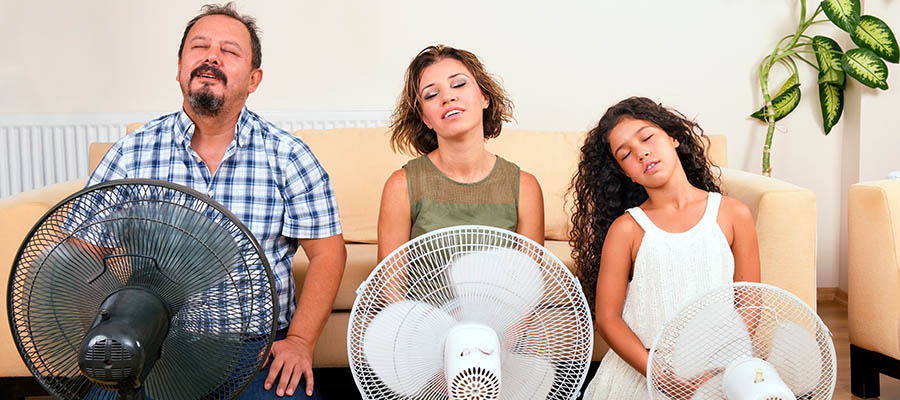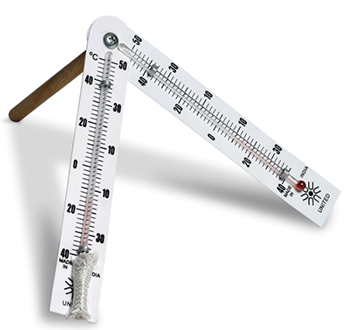

‘It’s not just the heat, it’s the humidity’
The problem arises in high humidity when the human body’s core temperature rises and our body begins to sweat to cool down, but sweating can only work if water is excreted from the skin and then it evaporates. If it’s humid and the air is filled with moisture then it’s difficult for the air to absorb the moisture (evaporate) from the sweat on our skin, resulting in us feeling hot and bothered.iii Prolonged high humidity leads to the body sweating profusely in an effort to cool itself down - but with no success it sweats some more and more until it dehydrates, overheats and experiences heatstroke where it’s forced to shut down often requiring emergency treatment.iv Be aware the symptoms of heat stroke can come suddenly without warning or creep up on you gradually.
How does evaporative cooling work?
If you've tested the wind direction by holding a wet finger up in the air or jumped out of a pool or shower and felt chilly, then that’s evaporative cooling. This is the very same principle that powers one of the oldest and simplest forms of evaporative cooling believed to be used first by ancient Egyptians. The wind would blow across wet reeds or wet cloths that the Egyptians had hung in the doorways/openings of their homes, then as water evaporated from these materials the inside of their homes would be cooled.v vi vii viii
When are evaporative coolers effective?
Evaporative coolers may have worked well for the ancient Egyptians because the air was hot and dry but in Australia evaporative coolers are only considered effective when the outdoor air relative humidity is below 30%, reasonably effective between 30-50% and above 50% humidity a refrigerative air conditioner is recommended.
 Sling Psychrometer used to measure relative humidityxi |
Relative humidity is measured using an instrument called a ‘sling psychrometer’ (Figure1) by calculating the difference between two mercury thermometers, one exposed to normal air (dry bulb) and the other wrapped in a wet wick (wet bulb).ix The higher the humidity, the lower the evaporation rate and higher the recorded temperature.x
An evaporative cooling system can be very successful if properly designed up to a wet bulb temperature of 22 degrees Celsius, and it can also be used in more humid areas (up to 24-25 °C) wet bulb, but the number of days where it is uncomfortable is considerably increased.
Evaporative coolers can be very effective on hot days, just as long as they are dry hot days. On those sweltering hot humid days, it's best just to run the fan only inside or you’ll have a steam room inside – the air conditioning industry doesn’t call evaporative coolers ‘swampies’ for no reason.
If humidity levels stay high for a few days, the moist pads that are designed make the evaporative cooler work can start to smell fishy and musty, and will definitely require service. Also be aware that higher levels of humidity within the home provide a thriving environment for dust mites and mould which are 2 undesirable triggers for asthma and allergy sufferers.xii
Despite the drawbacks listed above, evaporative cooling can still be a good solution as it all depends on your specific preferences and how tolerant you and your family are of those hot and humid days in Adelaide. For those who feel the heat and flush in the face, the best air conditioning solution is refrigerated air conditioning that comes with reverse cycle air conditioning in a split system or ducted system or maybe just skip new air conditioning and escape the heat and humidity by watching a blockbuster film at your local movie house!

If evaporative cooling is not the right for your family home consider making the switch to a reverse cycle system to escape those hot humid days PLUS you’ll gain the flexibility to have instant warmth for those chilly winter months.
*Just call or email us to inquire about the right solution for your home.
______________________________
i Australian Government Bureau of Metrology, 2017, http://www.bom.gov.au/climate/data
ii Wikipedia Climate of Adelaide, 2018, https://en.wikipedia.org/wiki/Climate_of_Adelaide
iii The Effects of Humidity, 2018, https://www.achooallergy.com/learning/the-effects-of-humidity-on-the-human-body/
iv Health Direct (2018) https://www.healthdirect.gov.au/heatstroke
v Malone, Alanna. "The Windcatcher House". Architectural Record: Building for Social Change. McGraw-Hill.
vi Folklore and Folklife in the United Arab Emirates; p. 167.
vii A. A'zami (May 2005). "Badgir in traditional Iranian architecture" (PDF). International Conference "Passive and Low Energy Cooling 1021 for the Built Environment", May 2005, Santorini, Greece. Retrieved 21 March 2012.
viii Windcatcher (2016) https://en.wikipedia.org/wiki/Windcatcher
ix Australian Bureau of meterology, 2018, http://www.bom.gov.au/climate/averages/climatology/relhum/calc-rh.pdf
x Designing Buildings Wiki (2014) https://www.designingbuildings.co.uk/wiki/Sling_psychrometer Nasco Supplies: https://www.enasco.com/p/SB51740M
xii National Asthma Council (2016) ‘Indoor Humidity Levels,’ http://www.sensitivechoice.com/indoor-humidity









